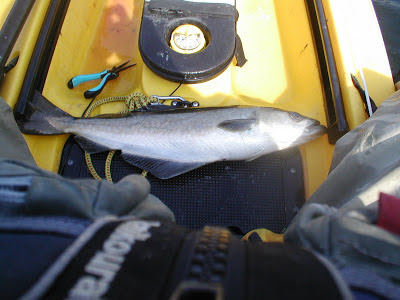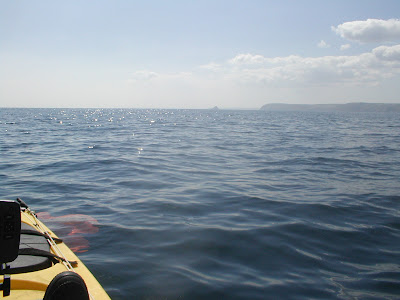The weather forecast for the weekend looked good with light winds forecasted for both Saturday and Sunday. I would have loved to fish both days but due to commitments, Saturday was the day.
I launched at 6:00 in the morning and everything looked good. The sea was calm, the sky was blue, and what a pleasure it was paddling out as the sun came up over the cliff.
My plan was to lure fish on the drift over a mixture of clean ground and rough ground. I would start the drift over clean ground and jig a Herring Rig using a 50g jig as the weight in the hope of Mackerel or Herring. Then when over the rough ground, jig a Savage Sandeel in the hope of Pollack, Wrasse, or possibly Cod. This method has been productive for me in the past producing a variety of species.
I launched at 6:00 in the morning and everything looked good. The sea was calm, the sky was blue, and what a pleasure it was paddling out as the sun came up over the cliff.
My plan was to lure fish on the drift over a mixture of clean ground and rough ground. I would start the drift over clean ground and jig a Herring Rig using a 50g jig as the weight in the hope of Mackerel or Herring. Then when over the rough ground, jig a Savage Sandeel in the hope of Pollack, Wrasse, or possibly Cod. This method has been productive for me in the past producing a variety of species.
 |
| Herring Rig with 50g Jig |
 |
| Savage Sandeel (bottom) |
The day started well. On the first drift, I hooked a Grey Gurnard over the clean ground. The fish took a mini feather of the Herring Rig.
From then on, it was like fishing in the Dead Sea. Apart from a very small Pollack there were no signs of any fish however, the weather and the conditions were still great.
By 11 o'clock and no more fish, it was clear that this was going to be a difficult day. My initial plan was to lure fish for the whole session however, whilst jigging the Herring Rig I managed to catch a Launce.
I decided to change tactics. I would use the launce and fish bait on the drift. One Launce was hardly enough bait for a long sessions fishing however, as I only intended to fish for another couple of hours that was fine. The bait rod was set up with a simple running ledger and a fillet of launce and the drift began.
It did not take long before there was a tap on the rod tip and to my delight up came a Plaice.
I continued with this method until the bait ran out but I never landed any more fish.
Although the winds were very light all day, the direction had changed to onshore. The sea at the launch site in the morning was flat calm.
The sea at the launch site when I came in was not so calm.
Knowing how easy it is, for the kayak to turn over in a split second if caught sideways on I always come in backwards. It takes me longer but at least I am facing what is coming and can control the kayak easier. It is amazing how, even with light winds, a combination of the direction of those winds and a spring tide can change the conditions so quickly.
Although I struggled to catch fish, I was pleased to catch something and despite a little bit of difficulty getting back to shore it was a good day.
I decided to change tactics. I would use the launce and fish bait on the drift. One Launce was hardly enough bait for a long sessions fishing however, as I only intended to fish for another couple of hours that was fine. The bait rod was set up with a simple running ledger and a fillet of launce and the drift began.
It did not take long before there was a tap on the rod tip and to my delight up came a Plaice.
I continued with this method until the bait ran out but I never landed any more fish.
Although the winds were very light all day, the direction had changed to onshore. The sea at the launch site in the morning was flat calm.
The sea at the launch site when I came in was not so calm.
Knowing how easy it is, for the kayak to turn over in a split second if caught sideways on I always come in backwards. It takes me longer but at least I am facing what is coming and can control the kayak easier. It is amazing how, even with light winds, a combination of the direction of those winds and a spring tide can change the conditions so quickly.
Although I struggled to catch fish, I was pleased to catch something and despite a little bit of difficulty getting back to shore it was a good day.






































